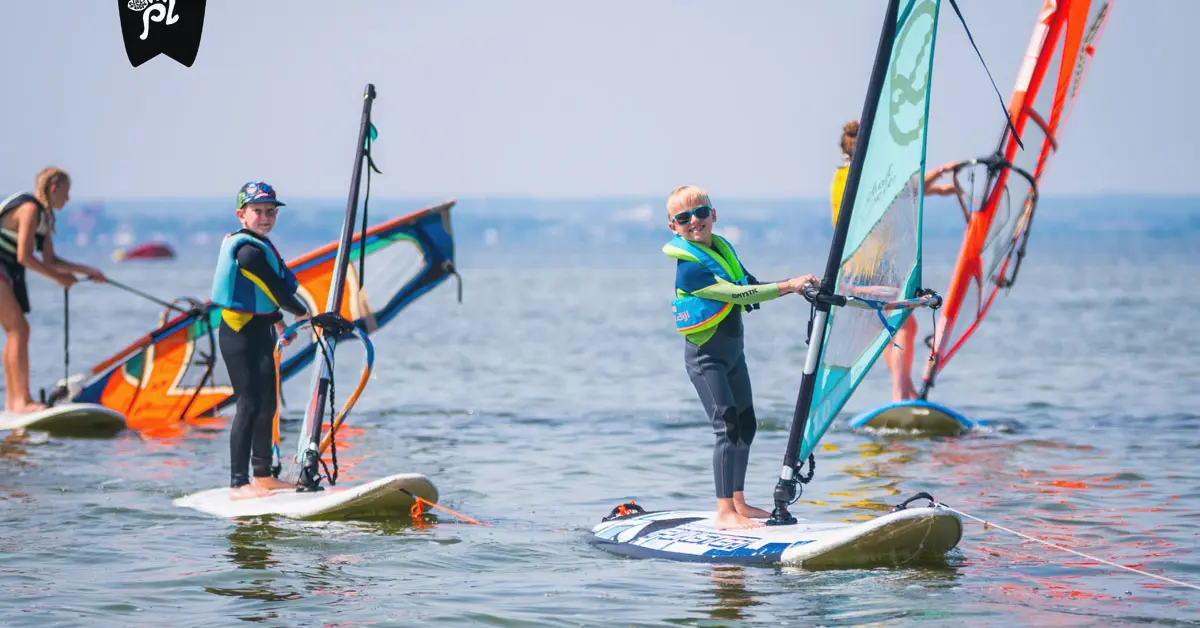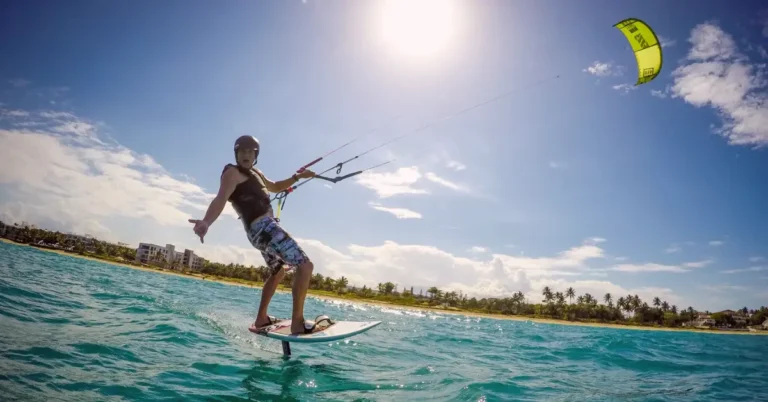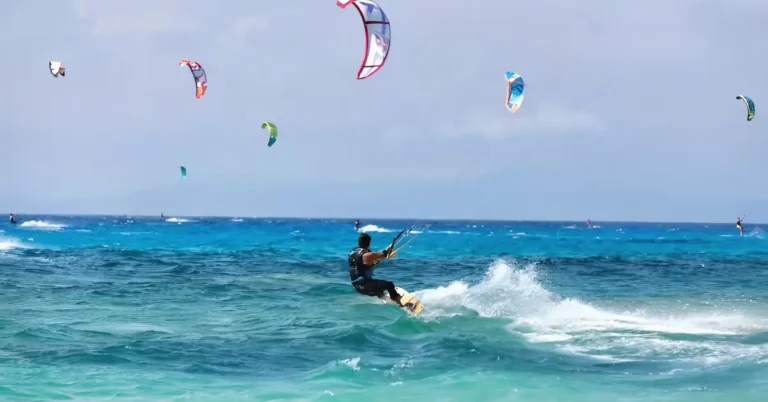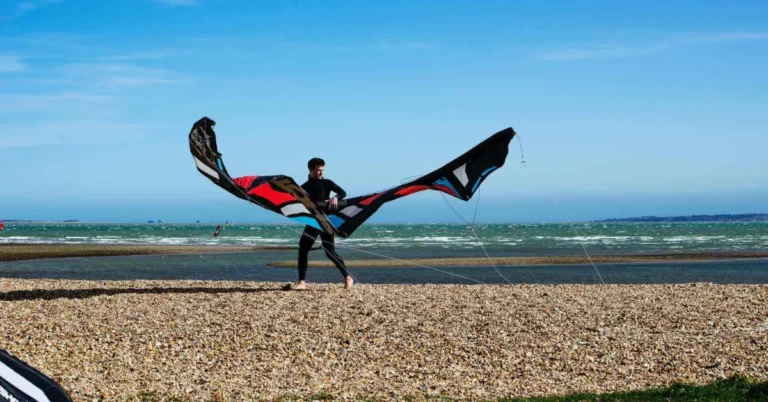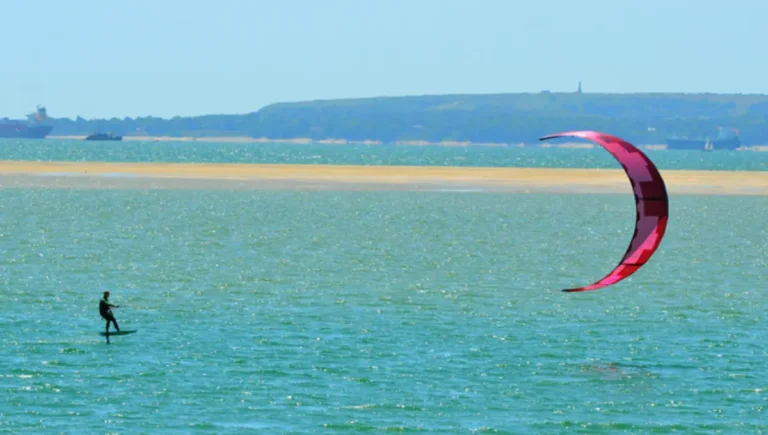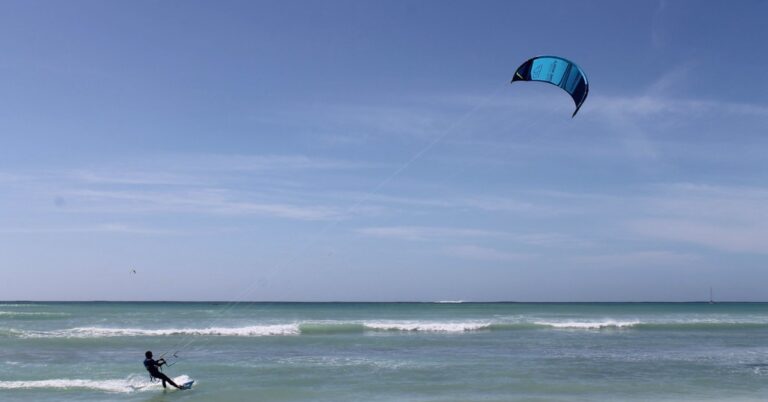Kitesurfing vs windsurfing: differences and similarities
Kitesurfing and windsurfing are two thrilling water sports that often spark debate among enthusiasts. Both offer exhilarating experiences on the water, but they differ in their equipment and techniques. The primary distinction lies in the gear used: windsurfing employs a sail attached to the board, while kitesurfing utilizes a kite resembling a parachute.
Despite this, both sports rely on harnessing the wind’s power to propel the rider across the water on a surfboard. The adrenaline rush of catching the wind can send participants soaring several meters into the air, categorizing these activities as extreme sports. Balance, speed, and the rush of adrenaline are common elements in both kitesurfing and windsurfing, yet each has its own nuances and learning curve.
Originating from surfing, these sports involve riding waves on a board, but with added complexities. While both require wind for propulsion, they differ from surfing in that momentum is generated through manipulation of the sail or kite rather than solely relying on wave energy. While they can ride waves, kitesurfing and windsurfing predominantly rely on wind power for acceleration and movement.
Also Read: Kiteboarding Gear Cost
Kitesurfing vs windsurfing
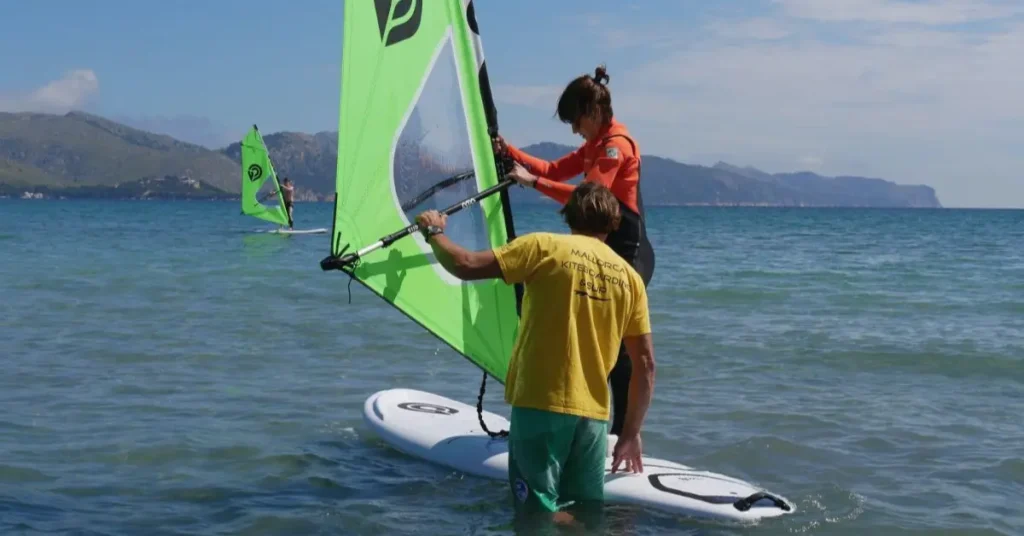
Kitesurfing, also known as kiteboarding, is a dynamic sport that blends elements of surfing with paragliding. Participants utilize a traction kite, commonly referred to as a kite, which is controlled by four or five lines.
Two of these lines are fixed to a bar for steering, while the remaining two or three lines, known as power lines, pass through the center of the bar and are connected to the rider via a harness.
While historical accounts suggest that kites were used for towing boats as far back as the 12th century by Chinese and Indonesian fishing communities, modern kitesurfing as a recognized sport dates back to 1977 when Gijsbertus Adrianus Panhuise patented a navigation system involving a surfboard pulled by a parachute-like kite.
Kitesurfing demands a level of strength, endurance, and coordination due to its inherent risks. It can significantly raise adrenaline levels, leading to a notable increase in blood pressure and heart rate, making it unsuitable for individuals with severe respiratory or cardiovascular issues.
Those with serious or recurring shoulder or knee injuries, diabetes, or inadequate swimming skills should also avoid the sport due to the heightened danger posed by potential accidents at sea. Despite its allure, kitesurfing requires mastery of both gliding through water and flying and necessitates control in the face of varying wave forces.
Windsurfing, on the other hand, entails riding over water on a board equipped with a sail. The boards used in windsurfing are generally lighter and easier to maneuver than those in kitesurfing, enabling more impressive jumps depending on the board type.
Mastery of both wind and wave conditions is essential in windsurfing. In addition to the sail and board, windsurfing requires equipment such as the mast, mast foot, boom, keel or fin, luffing board, harness, tether, adapter, and halyard.
Ease of Learning – Kitesurfing vs. Windsurfing
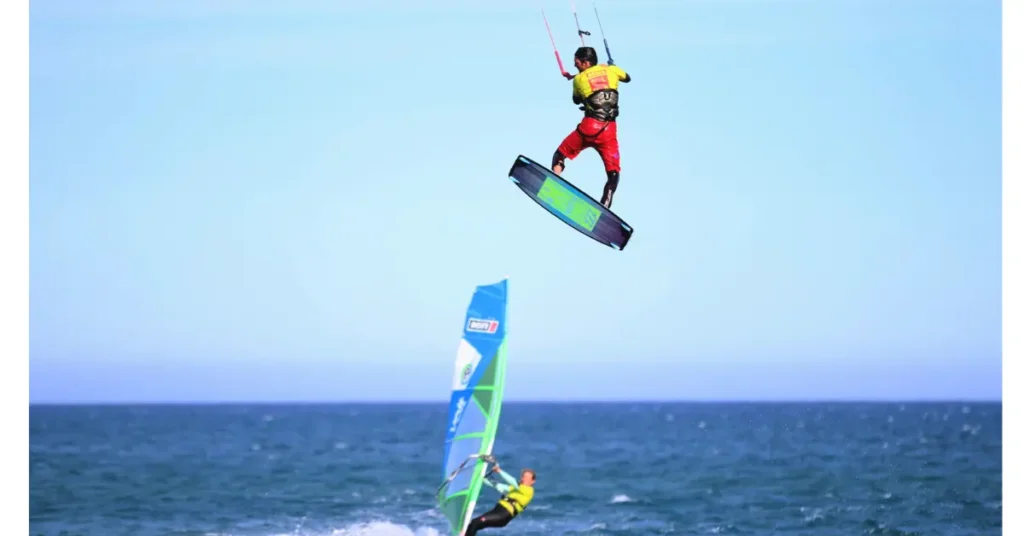
The debate over whether kitesurfing or windsurfing is easier to learn continues to spark discussions within their respective communities. Each sport presents its unique challenges and learning curves, leading to varying opinions on which is more accessible to beginners.
Many argue that windsurfing is simpler to grasp initially, as it involves fewer components to control during practice. Some find themselves able to engage in basic windsurfing within a matter of hours, although individual learning capabilities and skills play a significant role in this process.
Conversely, kitesurfing demands a deeper understanding of kite mechanics, which can entail spending considerable time on land mastering kite handling before venturing into the water. Once in the water, proficiency in maneuvering the kite while surfing further adds to the learning process, which may require sustained effort and information absorption.
While kitesurfing progression tends to be swift, windsurfing offers a longer journey of learning and skill development. Windsurfers often find themselves continuously refining techniques and acquiring new knowledge over an extended period.
Some proponents of kitesurfing argue that it requires minimal prerequisites and is more technically than physically demanding. Conversely, windsurfing demands a certain level of physical fitness and mental resilience due to its slower pace and intricate techniques involving various equipment components.
Ultimately, when considering which sport is quicker to learn, kitesurfing typically takes the lead. A five-day course is often recommended for kitesurfing, after which a significant proportion of learners become proficient enough to practice safely and continue improving independently.
In contrast, windsurfing is characterized as a long-term endeavor, with each step of the learning process requiring considerable time and dedication. For example, mastering the ability to plane, or glide swiftly over the water’s surface, can take an average of two to three years.
Is there an age restriction for participating in either sport?
Age limitations are not rigidly defined but rather dictated by the physical demands of each activity and the individual’s capabilities. Typically, the youngest participants are around 9 to 10 years old, while the oldest range from 60 to 65 years old. However, these age ranges can vary depending on the specific requirements of each sport and the aptitude of the individual.
For windsurfing, the minimum recommended starting age is also around 9 years old. This age guideline has become more feasible due to advancements in equipment, particularly lighter carbon masts. In the past, it was advisable to begin windsurfing from the age of 12, but technological improvements have made it more accessible to younger enthusiasts.
Kitesurfing equipment vs Windsurfing equipment
Distinguishing kitesurfing equipment from windsurfing equipment, one notable contrast emerges in durability. Windsurfing gear tends to exhibit greater resilience and longevity owing to its enhanced resistance. Typically, a kitesurfing kite boasts a lifespan of around three years, whereas a windsurfing sail can endure for approximately five years.
Moreover, in the unfortunate event of an accident, a kitesurfing kite is more prone to damage and can be challenging to repair compared to windsurfing equipment.
The longevity of both sets of gear hinges primarily on proper care and maintenance practices. Storing equipment away from water and sunlight when not in use is crucial. Before embarking on any water activities, it’s essential to meticulously inspect each component of the equipment to ensure its integrity and safety.
In terms of transportation, windsurfing equipment often presents more logistical challenges due to the unwieldy nature of the sail, which cannot be easily folded and tends to be heavy. Conversely, a kitesurfing kite is more conveniently stored in a bag alongside the board, making it simpler to transport.
Which one is more expensive, kitesurfing or windsurfing?
The financial aspect is a significant consideration when contemplating entry into kitesurfing or windsurfing. Both sports entail a notable investment, but windsurfing generally requires a larger financial outlay.
In economic terms, kitesurfing demands a certain level of purchasing power for classes and equipment, typically totaling around 2,500 euros. Conversely, windsurfing necessitates a more substantial initial investment, with costs starting at a minimum of 7,000 euros for essential equipment like boards, sails, and masts. Additionally, storage space for the equipment, such as a garage, is essential for windsurfing enthusiasts, adding to the overall expense.
Moreover, transportation logistics further contribute to the financial burden of windsurfing, as it often requires a sizable vehicle to transport the equipment comfortably.
Physical demand for kitesurfing vs windsurfing
As previously mentioned, windsurfing demands a higher level of physical fitness compared to kitesurfing. It serves as an excellent choice for individuals aiming to enhance their overall physical strength and conditioning. Windsurfing engages the entire body, requiring exertion from both the lower and upper body muscles.
The lower body plays a crucial role in maintaining balance on the board, while the upper body is responsible for controlling and maneuvering the sail.
On the other hand, while kitesurfing may not require as much physical effort as windsurfing, it still demands a good level of physical fitness, particularly in the legs and arms. Stability maintenance is primarily reliant on the strength and endurance of these muscle groups.
In summary, while both kitesurfing and windsurfing entail physical exertion, windsurfing places greater emphasis on overall body strength and conditioning, whereas kitesurfing requires focused strength in specific muscle groups for stability and control.
Which one is safer? kitesurfing or windsurfing?
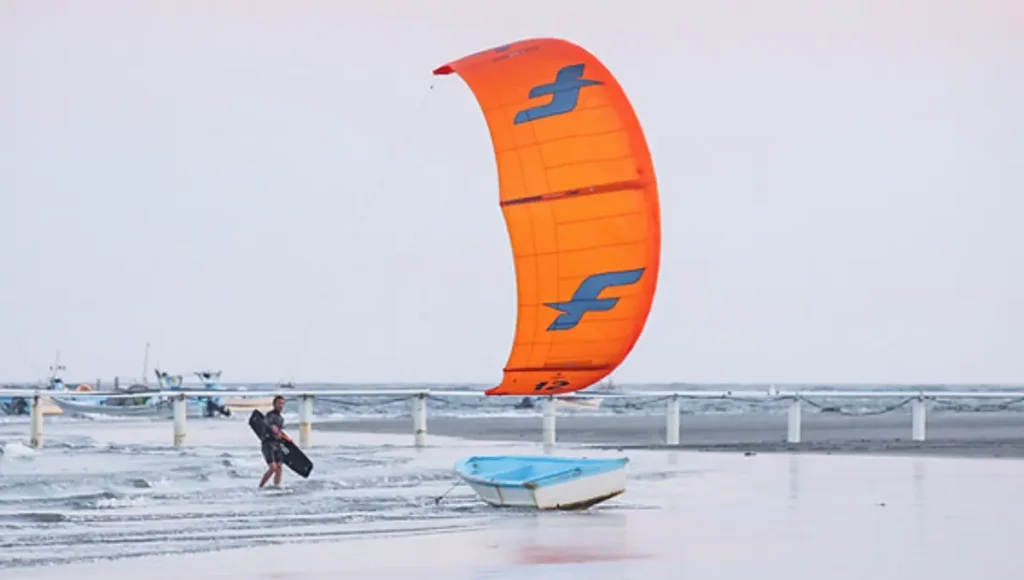
It’s widely acknowledged that kitesurfing carries a higher level of risk compared to windsurfing due to the potential severity of accidents.
Kitesurfing is often perceived as one of the most hazardous water sports, primarily because the kite’s movement is heavily dependent on wind conditions rather than solely on the kite’s control.
This reliance on wind dynamics can lead to situations where riders may struggle to manage the kite effectively, increasing the likelihood of accidents. Additionally, the power generated by the kite can be significant, resulting in more severe consequences if control is lost.
In contrast, windsurfing typically involves a more direct connection between the rider and the sail, providing greater control over maneuvers and reducing the risk of accidents stemming from uncontrollable external factors like wind gusts.
Overall, while both sports carry inherent risks, kitesurfing tends to be perceived as more dangerous due to the unpredictable nature of kite behavior in varying wind conditions.
kitesurfing accidents vs windsurfing accidents
Accidents in both sports often stem from insufficient experience. Many individuals overestimate their skill level, leading to inadequate reactions when faced with unexpected situations. However, the consequences of inexperience are typically more pronounced in kitesurfing.
In kitesurfing, accidents can have broader ramifications due to the kite’s potential to cause harm to individuals within a considerable distance, up to approximately 200 meters. Conversely, windsurfing accidents generally pose less risk to others, typically only affecting those close.
Independence of kitesurfing vs windsurfing
In terms of independence, windsurfing offers more autonomy compared to kitesurfing.
While it’s possible to kitesurf alone, assistance for launching and landing the kite is advisable. Windsurfing typically allows for solo sessions without assistance to get into the water.
However, regardless of the sport, guidance from experts during the initial learning stages is recommended to prevent the development of potentially harmful habits.
The rivalry between kitesurfing and windsurfing. Is there a war between them?
The rivalry between kitesurfing and windsurfing is undeniable, with practitioners of each sport often displaying a competitive edge. While they share commonalities, their differences are pronounced, leading to occasional friction on the beach.
Despite the playful banter and occasional claims of not wanting to associate with the other, there’s an underlying sense of envy between the two disciplines. It’s akin to a sibling rivalry, where each side harbors a bit of jealousy towards the other.
Kitesurfers and windsurfers can’t help but glance over their shoulders at each other, perhaps longing for a taste of what the other sport has to offer. It’s a natural aspect of their dynamic, driven by a shared love for the wind and the water.
What windsurfers envy about kitesurfing
In water sports, the contrast between windsurfing and kitesurfing is evident even in the gear they carry. Windsurfers stand out with their bulky board and the need for a spacious car, while kitesurfers enjoy the convenience of compact golf bags that easily fit in the trunk.
When traveling by plane, kitesurfers can discreetly stow their gear in a golf bag to avoid extra fees, while windsurfers face challenges due to the size of their equipment.
While windsurfing allows for impressive jumps, kitesurfing offers the exhilarating sensation of soaring skyward.
Despite the price reduction, windsurfing equipment remains notably more expensive than kitesurfing gear.
Kitesurfing boasts a quicker learning curve and allows for faster progression to higher technical levels than windsurfing.
Kitesurfing is more modern and “cooler”.
Kitesurfing and windsurfing are akin to skiing and snowboarding, offering different disciplines for varying conditions. Both sports allow practitioners to immerse themselves in nature, experiencing the thrill of being alone in the sea with their equipment. The freedom to push personal limits is boundless, with no restrictions other than the wind’s force, making each session an exhilarating adventure.
Is kitesurfing more fashionable than windsurfing?
Kitesurfing has transcended beyond a mere trend to become a thriving sport with significant economic impact. Tarifa, Spain, exemplifies this shift, with the town heavily reliant on kite and windsurfing tourism. Today, kitesurfing surpasses windsurfing in popularity, attracting the majority of visitors between May and September.
In the 80s, Tarifa lacked tourist appeal, but now it flourishes as a hub for watersports enthusiasts and lifestyle seekers. While some initially embraced kitesurfing as a fashion trend, it has evolved into a permanent fixture in the water sports scene, with many windsurfers transitioning to kitesurfing over time.
Pros and cons of Kitesurfing
Pros
Cons
Pros and cons of Windsurfing
Pros
Cons
Frequently Asked Questions
Conclusion
Kitesurfing offers a quicker learning curve and requires less physical effort, making it accessible to a broader range of enthusiasts. Its compact equipment and trendy appeal make it a popular choice among those seeking a fast-paced and exhilarating water sports experience.
On the other hand, windsurfing demands more time and physical stamina to master, but its sturdy equipment and greater speed potential offer a thrilling challenge for those willing to invest in the learning process.
Ultimately, the choice between windsurfing and kitesurfing boils down to personal preferences and priorities, whether it’s ease of learning, equipment convenience, or the desire for a more challenging endeavor. Both sports offer unique thrills and rewards, ensuring there’s something for everyone to enjoy on the waves.
